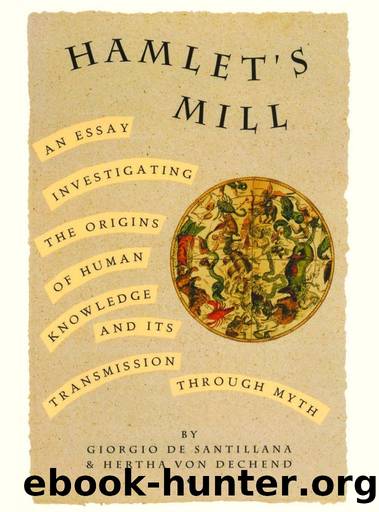Hamelet's Mill by Giorgio de Santillana

Author:Giorgio de Santillana [Santillana, Giorgio de]
Language: eng
Format: azw3
Tags: Philosophy
ISBN: 9780879232153
Publisher: Nonpareil Books
Published: 2014-03-24T00:00:00+00:00
Chapter XX. The Depths of the Sea
Hast thou entered into the springs of the sea?
Or hast thou walked in the search of the depth?
Job xxxviii.16
IT WILL HELP NOW to take a quick comparative look at the different âdialectsâ of mythical language as applied to âPhaethonâ in Greece and India. The Pythagoreans make Phaethon fall into Eridanus, burning part of its water, and glowing still at the time when the Argonauts passed by. Ovid stated that since that fall the Nile hides its sources. Rigveda 9.73.3 says that the Great Varuna has hidden the ocean. The Mahabharata tells in its own style why the âheavenly Gangaâ had to be brought down.1 At the end of the Golden Age (Krita Yuga) a class of Asura who had fought against the âgodsâ hid themselves in the ocean where the gods could not reach them, and planned to overthrow the government. So the gods implored Agastya (Canopus, alpha Carinae = Eridu) for help. The great Rishi did as he was bidden, drank up the water of the ocean, and thus laid bare the enemies, who were then slain by the gods. But now, there was no ocean anymore! Implored by the gods to fill the sea again, the Holy One replied: âThat water in sooth hath been digested by me. Some other expedient, therefore, must be thought of by you, if ye desire to make endeavour to fill the ocean.â It was this sad state of things which made it necessary to bring the Galaxy âdown.â This is reminiscent of the detail in the Jewish tradition about Eben Shetiyyah, that the waters sank down so deeply that David had to recite the âfifteen songs of ascensionâ to make them rise again.
Now Agastya, the great Rishi, had a âsordidâ origin similar to that of Erichthonios (Auriga), who was born of Gaia, âthe Earth,â from the seed of Hephaistos who had dropped it while he was looking at Athena.2 In the case of the Rishi:
He originated from the seed of Mitra and Varuna, which they dropped into a water-jar on seeing the heavenly Urvashi. From this double parentage he is called MaitrÄvaruni, and from his being born from a jar he got the name Khumbasambhava.â3 [Khumba is the name of Aquarius in India and Indonesia, allegedly late Greek influence.]
On the very same time and occasion there also was âbornâ as son of Mitra and Varunaâonly the seed fell on the ground not in the jarâthe Rishi Vasishtha. This is unmistakably zeta Ursae Majoris, and the lining up of Canopus with zeta, more often with Alcor, the tiny star near zeta (Torn Thumb, in Babylonia the âfoxâ-star) has remained a rather constant feature, in Arabic Suhayl and as-Suha. This is the âbirthâ of the valid representatives of both the poles, the sons of Mitra and Varuna and also of their successors. To follow up the long and laborious way leading from Rigvedic MitrÄvaruna (dual) to the latest days of the Roman Empire where we still find a
Download
This site does not store any files on its server. We only index and link to content provided by other sites. Please contact the content providers to delete copyright contents if any and email us, we'll remove relevant links or contents immediately.
Machine Learning at Scale with H2O by Gregory Keys | David Whiting(4259)
Never by Ken Follett(3884)
Harry Potter and the Goblet Of Fire by J.K. Rowling(3808)
Unfinished: A Memoir by Priyanka Chopra Jonas(3356)
Fairy Tale by Stephen King(3307)
The Man Who Died Twice by Richard Osman(3040)
Will by Will Smith(2872)
Rationality by Steven Pinker(2327)
The Dark Hours by Michael Connelly(2280)
Can't Hurt Me: Master Your Mind and Defy the Odds - Clean Edition by David Goggins(2277)
It Starts With Us (It Ends with Us #2) by Colleen Hoover(2256)
The Storyteller by Dave Grohl(2198)
Friends, Lovers, and the Big Terrible Thing by Matthew Perry(2182)
The Dawn of Everything: A New History of Humanity by David Graeber & David Wengrow(2156)
The Becoming by Nora Roberts(2151)
The Stranger in the Lifeboat by Mitch Albom(2093)
Cloud Cuckoo Land by Anthony Doerr(2059)
Love on the Brain by Ali Hazelwood(2024)
Einstein: His Life and Universe by Walter Isaacson(1985)
